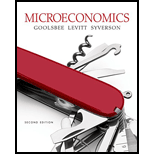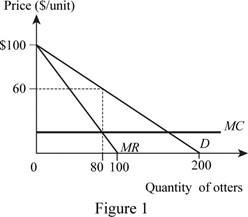
(a)
The market
(a)
Explanation of Solution
The market demand curve for Otters is given as
The marginal revenue of the market can be derived as follows:
The market marginal revenue is
By substituting the value of Q in the demand equation, the
Thus, the market demand curve can be illustrated as follows:

The monopoly output and price are 80 units and $60 per unit.
Imperfect competition: The imperfect competition is the market structure where there are many sellers selling the differentiated products and there will be information asymmetry in the market which provides some market control to the producers.
(b)
The output in the market by A.
(b)
Explanation of Solution
When firm J announces that half of the monopoly output would be brought by J, firm J would bring 40 units. By knowing this, the residual demand for A can be calculated as follows:
Inverse demand equation (Price) for firm A can be calculated as follows:
Thus, the marginal revenue curve of A will be
Thus, A's profit maximizing output would be 60 units.
(c)
Industrial output, price, and each seller's profit.
(c)
Explanation of Solution
The output by J is 40 units and the output by A is 60 units, which means that the total industrial output would be the summation of these two which is equal to 100 units. The price can be calculated by substituting the values of the two quantities in the demand function as follows:
Thus, the price of the market would be $50 per unit. Thus, the profit of each seller can be calculated as follows:
Similarly, the profit of A can be calculated as follows:
Thus, the profit of A is $1,800 and that of J is $1,200.
(d)
Industrial output, price, and each seller's profit.
(d)
Explanation of Solution
When firm J knows that the output brought by A is 60 units, the residual demand for the J can be calculated as follows:
Inverse demand equation (Price) for firm J can be calculated as follows:
Thus, the marginal revenue curve of J will be
Thus, J's profit maximizing output would be 50 units. The output by J is 50 units and the output by A is 60 units, which means that the total industrial output would be the summation of these two which is equal to 110 units. The price can be calculated by substituting the values of the two quantities in the demand function as follows:
Thus, the price of the market would be $45 per unit. Thus, the profit of each seller can be calculated as follows:
Similarly, the profit of A can be calculated as follows:
Thus, the profit of A is $1,500 and that of J is $1,250.
(e)
Cournot equilibrium in the economy.
(e)
Explanation of Solution
The market demand curve is
The marginal revenue of firm J can be calculated as follows:
Thus, the marginal revenue curve for J will be
The marginal revenue of firm A can be calculated as follows:
Thus, the marginal revenue curve for J will be
Similarly, A can be calculated as follows:
Thus, by substituting the reaction function of A in J the equilibrium output can be provided as follows:
Since A also faces the identical problem, the output of A will also be 53.33. Thus, the total output is 106.66 and this can be substituted in the market demand in order to calculate the market price as follows:
Thus, the Cournot equilibrium price is $46.67 and the output is 53.33. Since part d calculated the outputs and prices that are different, they are not Cournot equilibrium prices and outputs.
Want to see more full solutions like this?
Chapter 11 Solutions
Microeconomics
- Please help me with this Accounting questionarrow_forwardTitle: Does the educational performance depend on its literacy rate and government spending over the last 10 years? In the introduction, there are four things to include:a) Clearly state your research topic follows by country’s background in terms of (population density; male/female ratio; and identify the problem leading up to the study of it, such as government spending and adult literacy rate. How does the US perform compared to other countries.b) State the research question that you wish to resolve: Does the US economic performance depend on its government spending on education and the literacy rate over the last 10 years. Define performance (Y) as the average income per capita, an indicator of the country’s economy growing over time. For example, an increase in government spending leads to higher literacy rates and subsequently higher productivity in the economy. Also, mention that you will use a sample size of 10 years of secondary data from the existing literature,…arrow_forwardTitle: Does the educational performance depend on its literacy rate and government spending over the last 10 years? In the introduction, there are four things to include:a) Clearly state your research topic follows by country’s background in terms of (population density; male/female ratio; and identify the problem leading up to the study of it, such as government spending and adult literacy rate. How does the US perform compared to other countries.b) State the research question that you wish to resolve: Does the US economic performance depend on its government spending on education and the literacy rate over the last 10 years. Define performance (Y) as the average income per capita, an indicator of the country’s economy growing over time. For example, an increase in government spending leads to higher literacy rates and subsequently higher productivity in the economy. Also, mention that you will use a sample size of 10 years of secondary data from the existing literature,…arrow_forward
- Explain how the introduction of egg replacers and plant-based egg products will impact the bakery industry. Provide a graphical representation.arrow_forwardExplain Professor Frederick's "cognitive reflection" test.arrow_forward11:44 Fri Apr 4 Would+You+Take+the+Bird+in+the+Hand Would You Take the Bird in the Hand, or a 75% Chance at the Two in the Bush? BY VIRGINIA POSTREL WOULD you rather have $1,000 for sure or a 90 percent chance of $5,000? A guaranteed $1,000 or a 75 percent chance of $4,000? In economic theory, questions like these have no right or wrong answers. Even if a gamble is mathematically more valuable a 75 percent chance of $4,000 has an expected value of $3,000, for instance someone may still prefer a sure thing. People have different tastes for risk, just as they have different tastes for ice cream or paint colors. The same is true for waiting: Would you rather have $400 now or $100 every year for 10 years? How about $3,400 this month or $3,800 next month? Different people will answer differently. Economists generally accept those differences without further explanation, while decision researchers tend to focus on average behavior. In decision research, individual differences "are regarded…arrow_forward
- Describe the various measures used to assess poverty and economic inequality. Analyze the causes and consequences of poverty and inequality, and discuss potential policies and programs aimed at reducing them, assess the adequacy of current environmental regulations in addressing negative externalities. analyze the role of labor unions in labor markets. What is one benefit, and one challenge associated with labor unions.arrow_forwardEvaluate the effectiveness of supply and demand models in predicting labor market outcomes. Justify your assessment with specific examples from real-world labor markets.arrow_forwardExplain the difference between Microeconomics and Macroeconomics? 2.) Explain what fiscal policy is and then explain what Monetary Policy is? 3.) Why is opportunity cost and give one example from your own of opportunity cost. 4.) What are models and what model did we already discuss in class? 5.) What is meant by scarcity of resources?arrow_forward
- 2. What is the payoff from a long futures position where you are obligated to buy at the contract price? What is the payoff from a short futures position where you are obligated to sell at the contract price?? Draw the payoff diagram for each position. Payoff from Futures Contract F=$50.85 S1 Long $100 $95 $90 $85 $80 $75 $70 $65 $60 $55 $50.85 $50 $45 $40 $35 $30 $25 Shortarrow_forward3. Consider a call on the same underlier (Cisco). The strike is $50.85, which is the forward price. The owner of the call has the choice or option to buy at the strike. They get to see the market price S1 before they decide. We assume they are rational. What is the payoff from owning (also known as being long) the call? What is the payoff from selling (also known as being short) the call? Payoff from Call with Strike of k=$50.85 S1 Long $100 $95 $90 $85 $80 $75 $70 $65 $60 $55 $50.85 $50 $45 $40 $35 $30 $25 Shortarrow_forward4. Consider a put on the same underlier (Cisco). The strike is $50.85, which is the forward price. The owner of the call has the choice or option to buy at the strike. They get to see the market price S1 before they decide. We assume they are rational. What is the payoff from owning (also known as being long) the put? What is the payoff from selling (also known as being short) the put? Payoff from Put with Strike of k=$50.85 S1 Long $100 $95 $90 $85 $80 $75 $70 $65 $60 $55 $50.85 $50 $45 $40 $35 $30 $25 Shortarrow_forward

 Principles of Economics (12th Edition)EconomicsISBN:9780134078779Author:Karl E. Case, Ray C. Fair, Sharon E. OsterPublisher:PEARSON
Principles of Economics (12th Edition)EconomicsISBN:9780134078779Author:Karl E. Case, Ray C. Fair, Sharon E. OsterPublisher:PEARSON Engineering Economy (17th Edition)EconomicsISBN:9780134870069Author:William G. Sullivan, Elin M. Wicks, C. Patrick KoellingPublisher:PEARSON
Engineering Economy (17th Edition)EconomicsISBN:9780134870069Author:William G. Sullivan, Elin M. Wicks, C. Patrick KoellingPublisher:PEARSON Principles of Economics (MindTap Course List)EconomicsISBN:9781305585126Author:N. Gregory MankiwPublisher:Cengage Learning
Principles of Economics (MindTap Course List)EconomicsISBN:9781305585126Author:N. Gregory MankiwPublisher:Cengage Learning Managerial Economics: A Problem Solving ApproachEconomicsISBN:9781337106665Author:Luke M. Froeb, Brian T. McCann, Michael R. Ward, Mike ShorPublisher:Cengage Learning
Managerial Economics: A Problem Solving ApproachEconomicsISBN:9781337106665Author:Luke M. Froeb, Brian T. McCann, Michael R. Ward, Mike ShorPublisher:Cengage Learning Managerial Economics & Business Strategy (Mcgraw-...EconomicsISBN:9781259290619Author:Michael Baye, Jeff PrincePublisher:McGraw-Hill Education
Managerial Economics & Business Strategy (Mcgraw-...EconomicsISBN:9781259290619Author:Michael Baye, Jeff PrincePublisher:McGraw-Hill Education





